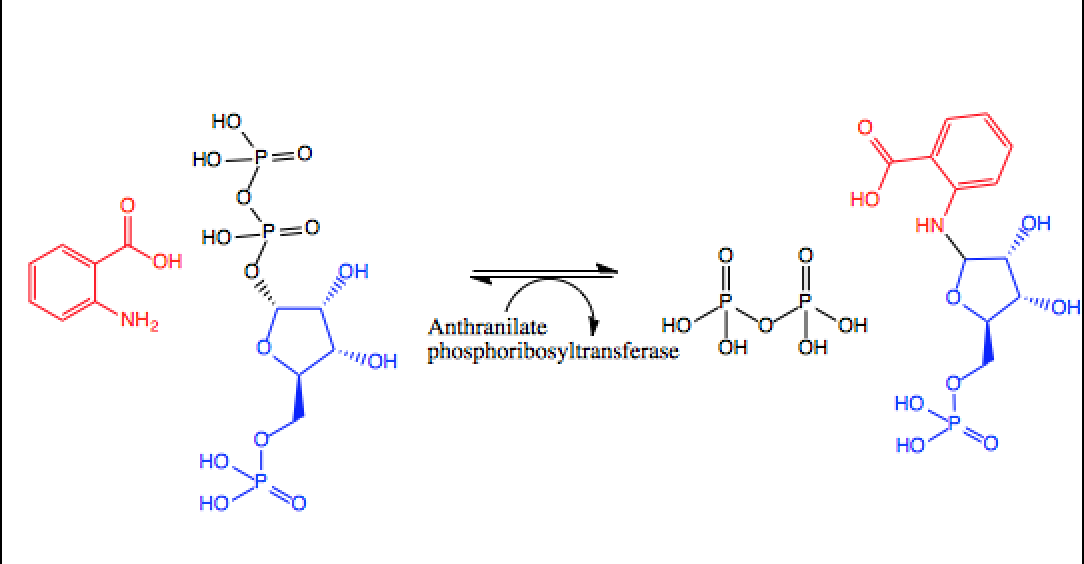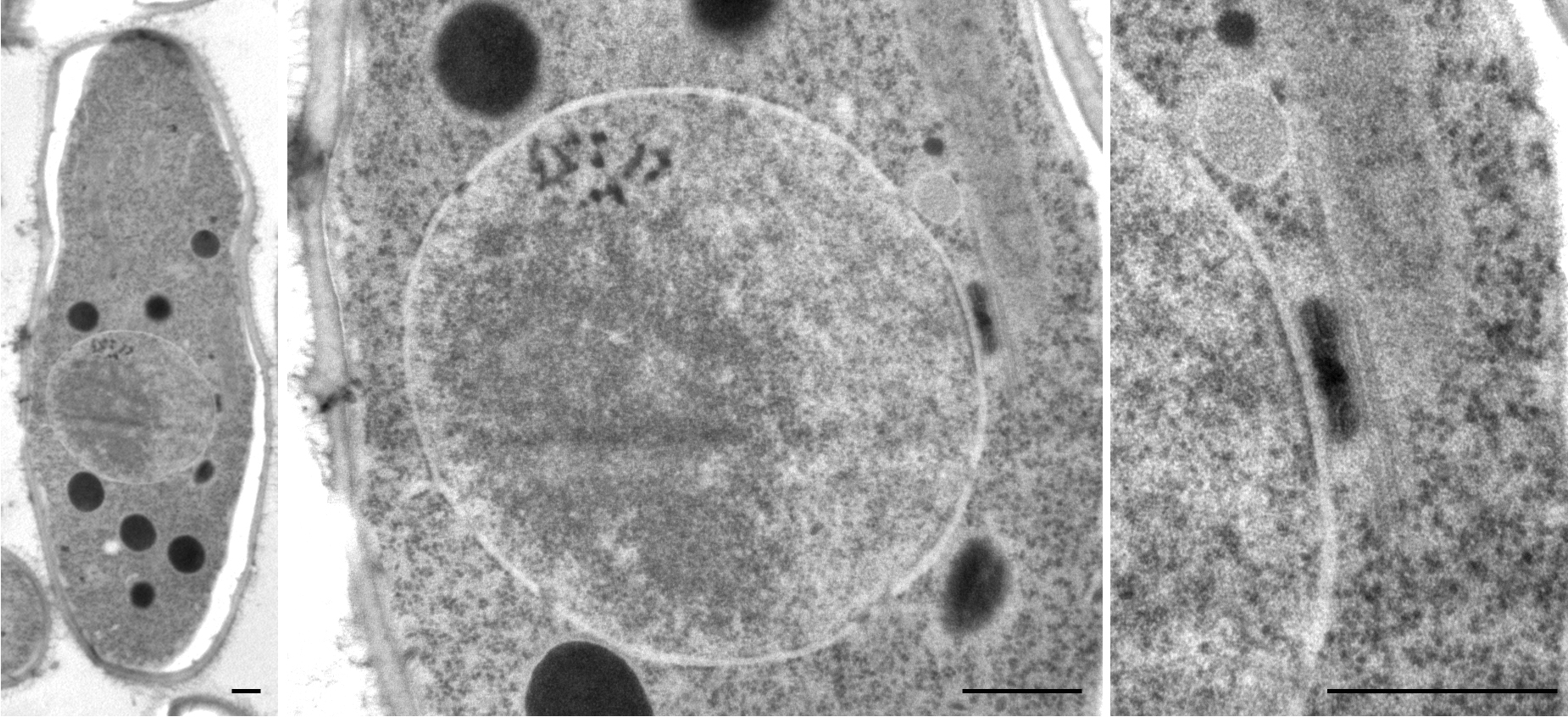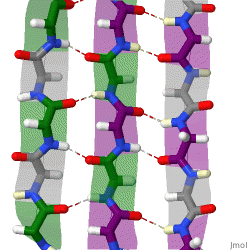|
Anthranilate Phosphoribosyltransferase
In enzymology, an anthranilate phosphoribosyltransferase () is an enzyme that catalysis, catalyzes the chemical reaction :anthranilate + phosphoribosyl pyrophosphate \rightleftharpoons N-(5-phosphoribosyl)-anthranilate + diphosphate The two substrate (biochemistry), substrates of this enzyme are anthranilate and phosphoribosyl pyrophosphate. Its two product (chemistry), products are N-(5-phosphoribosyl)-anthranilate and diphosphate. This enzyme participates in aromatic amino acid biosynthesis and two-component system (general). Nomenclature This enzyme belongs to the family of glycosyltransferases, specifically the pentosyltransferases. The List of enzymes, systematic name of this enzyme class is N-(5-phospho-D-ribosyl)-anthranilate:diphosphate phospho-alpha-D-ribosyltransferase. Other names in common use are: * anthranilate 5-phosphoribosylpyrophosphate * anthranilate phosphoribosylpyrophosphate phosphoribosyltransferase * anthranilate-PP-ribose-P phosphoribosyltransferas ... [...More Info...] [...Related Items...] OR: [Wikipedia] [Google] [Baidu] |
Enzymology
An enzyme () is a protein that acts as a biological catalyst by accelerating chemical reactions. The molecules upon which enzymes may act are called substrate (chemistry), substrates, and the enzyme converts the substrates into different molecules known as product (chemistry), products. Almost all metabolism, metabolic processes in the cell (biology), cell need enzyme catalysis in order to occur at rates fast enough to sustain life. Metabolic pathways depend upon enzymes to catalyze individual steps. The study of enzymes is called ''enzymology'' and the field of pseudoenzyme, pseudoenzyme analysis recognizes that during evolution, some enzymes have lost the ability to carry out biological catalysis, which is often reflected in their amino acid sequences and unusual 'pseudocatalytic' properties. Enzymes are known to catalyze more than 5,000 biochemical reaction types. Other biocatalysts include Ribozyme, catalytic RNA molecules, also called ribozymes. They are sometimes descr ... [...More Info...] [...Related Items...] OR: [Wikipedia] [Google] [Baidu] |
Tertiary Structure
Protein tertiary structure is the three-dimensional shape of a protein. The tertiary structure will have a single polypeptide chain "backbone" with one or more protein secondary structures, the protein domains. Amino acid side chains and the backbone may interact and bond in a number of ways. The interactions and bonds of side chains within a particular protein determine its tertiary structure. The protein tertiary structure is defined by its atomic coordinates. These coordinates may refer either to a protein domain or to the entire tertiary structure. A number of these structures may bind to each other, forming a quaternary structure. History The science of the tertiary structure of proteins has progressed from one of hypothesis to one of detailed definition. Although Emil Fischer had suggested proteins were made of polypeptide chains and amino acid side chains, it was Dorothy Maud Wrinch who incorporated geometry into the prediction of protein structures. Wrinch demon ... [...More Info...] [...Related Items...] OR: [Wikipedia] [Google] [Baidu] |
Oryza Sativa
''Oryza sativa'', having the common name Asian cultivated rice, is the much more common of the two rice species cultivated as a cereal, the other species being ''Oryza glaberrima, O. glaberrima'', African rice. It was History of rice cultivation, first domesticated in the Yangtze River basin in China 13,500 to 8,200 years ago. ''Oryza sativa'' belongs to the genus ''Oryza'' and the BOP clade in the grass family Poaceae. With a genome consisting of 430megabase, Mbp across 12 chromosomes, it is renowned for being easy to Genetically modified rice, genetically modify and is a model organism for the study of the biology of cereals and Monocotyledon, monocots. Description ''O. sativa'' has an erect stalk stem that grows tall, with a smooth surface. The leaf is lanceolate, long, and grows from a ligule long. Image:Kerbau Jawa.jpg, Domestic buffalo, Water buffalo ploughing a rice paddyfield, Java File:Jumli Marshi Oryza sativa Rice.jpg, Jumli Marshi, brown rice from Nepal File: ... [...More Info...] [...Related Items...] OR: [Wikipedia] [Google] [Baidu] |
Arabidopsis Thaliana
''Arabidopsis thaliana'', the thale cress, mouse-ear cress or arabidopsis, is a small plant from the mustard family (Brassicaceae), native to Eurasia and Africa. Commonly found along the shoulders of roads and in disturbed land, it is generally considered a weed. A winter annual with a relatively short lifecycle, ''A. thaliana'' is a popular model organism in plant biology and genetics. For a complex multicellular eukaryote, ''A. thaliana'' has a relatively small genome of around 135 Base pair#Length measurements, megabase pairs. It was the first plant to have its genome sequenced, and is an important tool for understanding the molecular biology of many plant traits, including flower development and phototropism, light sensing. Description ''Arabidopsis thaliana'' is an annual plant, annual (rarely biennial plant, biennial) plant, usually growing to 20–25 cm tall. The leaf, leaves form a rosette at the base of the plant, with a few leaves also on the flowering Plant ste ... [...More Info...] [...Related Items...] OR: [Wikipedia] [Google] [Baidu] |
Neurospora Crassa
''Neurospora crassa'' is a type of red bread mold of the phylum Ascomycota. The genus name, meaning 'nerve spore' in Greek, refers to the characteristic striations on the spores. The first published account of this fungus was from an infestation of French bakeries in 1843. ''Neurospora crassa'' is used as a model organism because it is easy to grow and has a haploid life cycle that makes genetics, genetic analysis simple since recessive traits will show up in the offspring. Analysis of genetic recombination is facilitated by the ordered arrangement of the products of meiosis in ''Neurospora'' ascospores. Its entire genome of seven chromosomes has been sequenced. ''Neurospora'' was used by Edward Tatum and George Wells Beadle in their experiments for which they won the Nobel Prize in Physiology or Medicine in 1958. Beadle and Tatum exposed ''N. crassa'' to x-rays, causing mutations. They then observed failures in metabolic pathways caused by errors in specific enzymes. This led ... [...More Info...] [...Related Items...] OR: [Wikipedia] [Google] [Baidu] |
Magnaporthe Grisea
''Magnaporthe grisea'', also known as rice blast fungus, rice rotten neck, rice seedling blight, blast of rice, oval leaf spot of graminea, pitting disease, ryegrass blast, Johnson spot, neck blast, wheat blast and , is a plant-pathogenic fungus and model organism that causes a serious disease affecting rice. It is now known that ''M. grisea'' consists of a cryptic species complex containing at least two biological species that have clear genetic differences and do not interbreed. Complex members isolated from '' Digitaria'' have been more narrowly defined as ''M. grisea''. The remaining members of the complex isolated from rice and a variety of other hosts have been renamed ''Magnaporthe oryzae'', within the same ''M. grisea'' complex. Confusion on which of these two names to use for the rice blast pathogen remains, as both are now used by different authors. Members of the ''M. grisea'' complex can also infect other agriculturally important cereals including ... [...More Info...] [...Related Items...] OR: [Wikipedia] [Google] [Baidu] |
Schizosaccharomyces Pombe
''Schizosaccharomyces pombe'', also called "fission yeast", is a species of yeast used in traditional brewing and as a model organism in molecular and cell biology. It is a unicellular eukaryote, whose cells are rod-shaped. Cells typically measure 3 to 4 micrometres in diameter and 7 to 14 micrometres in length. Its genome, which is approximately 14.1 million base pairs, is estimated to contain 4,970 protein-coding genes and at least 450 non-coding RNAs. These cells maintain their shape by growing exclusively through the cell tips and divide by medial fission to produce two daughter cells of equal size, which makes them a powerful tool in cell cycle research. Fission yeast was isolated in 1893 by Paul Lindner from East African millet beer. The species name ''pombe'' is the Swahili word for beer. It was first developed as an experimental model in the 1950s: by Urs Leupold for studying genetics, and by Murdoch Mitchison for studying the cell cycle. Paul Nurse, a fission ... [...More Info...] [...Related Items...] OR: [Wikipedia] [Google] [Baidu] |
Kluyveromyces Lactis
''Kluyveromyces lactis'' is a ''Kluyveromyces'' yeast commonly used for genetic studies and industrial applications. Its name comes from the ability to assimilate lactose and convert it into lactic acid. ''Kluyveromyces lactis'' (formerly ''Saccharomyces lactis'') is a yeast which has the ability to assimilate lactose and convert it into lactic acid. ''K. lactis'' and other organisms i.e., ''Aspergillus niger'' var awamori and ''Escherichia coli'' K-12 are grown in fermenters to produce chymosin (rennet) on a commercial scale; this rennet, which replaces the conventional form obtained from slaughtered animals, is now widely used in cheese production. Yeasts and fungi are ideal organisms for comparative genomic studies in eukaryotes because of their small and compact genomes and because they include a number of species such as ''Neurospora crassa'', ''Saccharomyces cerevisiae'' and ''Schizosaccharomyces pombe'', that have been, and continue to be, used extensively in genetic s ... [...More Info...] [...Related Items...] OR: [Wikipedia] [Google] [Baidu] |
Saccharomyces Cerevisiae
''Saccharomyces cerevisiae'' () (brewer's yeast or baker's yeast) is a species of yeast (single-celled fungal microorganisms). The species has been instrumental in winemaking, baking, and brewing since ancient times. It is believed to have been originally isolated from the skin of grapes. It is one of the most intensively studied eukaryotic model organisms in molecular and cell biology, much like '' Escherichia coli'' as the model bacterium. It is the microorganism which causes many common types of fermentation. ''S. cerevisiae'' cells are round to ovoid, 5–10 μm in diameter. It reproduces by budding. Many proteins important in human biology were first discovered by studying their homologs in yeast; these proteins include cell cycle proteins, signaling proteins, and protein-processing enzymes. ''S. cerevisiae'' is currently the only yeast cell known to have Berkeley bodies present, which are involved in particular secretory pathways. Antibodies again ... [...More Info...] [...Related Items...] OR: [Wikipedia] [Google] [Baidu] |
Beta Sheet
The beta sheet (β-sheet, also β-pleated sheet) is a common motif of the regular protein secondary structure. Beta sheets consist of beta strands (β-strands) connected laterally by at least two or three backbone hydrogen bonds, forming a generally twisted, pleated sheet. A β-strand is a stretch of polypeptide chain typically 3 to 10 amino acids long with backbone in an extended conformation. The supramolecular association of β-sheets has been implicated in the formation of the fibrils and protein aggregates observed in amyloidosis, Alzheimer's disease and other proteinopathies. History The first β-sheet structure was proposed by William Astbury in the 1930s. He proposed the idea of hydrogen bonding between the peptide bonds of parallel or antiparallel extended β-strands. However, Astbury did not have the necessary data on the bond geometry of the amino acids in order to build accurate models, especially since he did not then know that the peptide bond was planar. ... [...More Info...] [...Related Items...] OR: [Wikipedia] [Google] [Baidu] |
Alpha Helices
An alpha helix (or α-helix) is a sequence of amino acids in a protein that are twisted into a coil (a helix). The alpha helix is the most common structural arrangement in the secondary structure of proteins. It is also the most extreme type of local structure, and it is the local structure that is most easily predicted from a sequence of amino acids. The alpha helix has a right-handed helix conformation in which every backbone N−H group hydrogen bonds to the backbone C=O group of the amino acid that is four residues earlier in the protein sequence. Other names The alpha helix is also commonly called a: * Pauling–Corey–Branson α-helix (from the names of three scientists who described its structure) * 3.613-helix because there are 3.6 amino acids in one ring, with 13 atoms being involved in the ring formed by the hydrogen bond (starting with amidic hydrogen and ending with carbonyl oxygen) Discovery In the early 1930s, William Astbury showed that there were dras ... [...More Info...] [...Related Items...] OR: [Wikipedia] [Google] [Baidu] |
Active Site
In biology and biochemistry, the active site is the region of an enzyme where substrate molecules bind and undergo a chemical reaction. The active site consists of amino acid residues that form temporary bonds with the substrate, the ''binding site'', and residues that catalyse a reaction of that substrate, the ''catalytic site''. Although the active site occupies only ~10–20% of the volume of an enzyme, it is the most important part as it directly catalyzes the chemical reaction. It usually consists of three to four amino acids, while other amino acids within the protein are required to maintain the tertiary structure of the enzymes. Each active site is evolved to be optimised to bind a particular substrate and catalyse a particular reaction, resulting in high specificity. This specificity is determined by the arrangement of amino acids within the active site and the structure of the substrates. Sometimes enzymes also need to bind with some cofactors to fulfil their functio ... [...More Info...] [...Related Items...] OR: [Wikipedia] [Google] [Baidu] |







